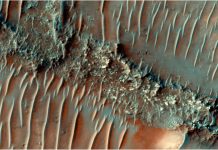
NASA’s Curiosity Mars Rover has brought to light one of the most baffling discoveries on Mars—the presence of methane gas in Gale Crater.
This finding is intriguing because methane is often produced by living organisms on Earth, and yet, there’s no convincing evidence of life, past or present, on Mars.
Researchers are now exploring alternative explanations for how methane could be appearing and disappearing on the Red Planet, as detailed in recent studies published in the Journal of Geophysical Research: Planets.
Methane is tricky; it shows up at night and vanishes by day, and its levels seem to fluctuate with the seasons, occasionally spiking significantly.
These patterns are puzzling, especially since the European Space Agency’s Trace Gas Orbiter, orbiting Mars to specifically study atmospheric gases, has not detected methane at all.
The scientists at NASA’s Jet Propulsion Laboratory, who are leading the Curiosity mission, along with researchers from NASA’s Goddard Space Flight Center, have proposed a new theory.
They believe that the methane could be trapped underground under seals of solidified salt within the Martian soil, which is known as regolith. This sealed methane could be released when the seals are weakened by temperature changes or physically disturbed, possibly by the rover itself.
The theory began to take shape following a series of experiments started by Alexander Pavlov, a planetary scientist at NASA Goddard. Pavlov remembered an unrelated experiment from 2017 involving microorganisms and Martian permafrost, which unexpectedly formed a crust of salt when the ice turned directly into gas.
This memory clicked when a sudden burst of methane was detected by Curiosity’s tunable laser spectrometer, a part of the onboard chemistry lab known as Sample Analysis at Mars (SAM).
To further test this theory, Pavlov’s team conducted experiments using samples of Martian-like permafrost infused with varying concentrations of perchlorate—a salt commonly found on Mars. They simulated Martian conditions in a chamber, adjusting temperatures and air pressure, and monitored how gases behaved under these soil samples.
They discovered that a seal could form under conditions found on Mars within a few days in samples containing higher concentrations of perchlorate.
Although the concentration of perchlorate used in the experiments was higher than what has been measured by Curiosity in Gale Crater, Martian regolith contains other types of salts, like sulfates, which the researchers plan to study next.
This hypothesis, if proven correct, could explain why methane detections are so inconsistent and localized to Gale Crater, where Curiosity operates.
It could also illuminate how methane might be generated or stored in other regions of Mars, potentially forming or breaking seals over time due to environmental changes.
Understanding methane on Mars is crucial because it could provide insights into past or present geological or even biological processes. The ongoing research and future missions aim to equip Mars rovers with instruments capable of continuously monitoring methane, helping to solve this planetary puzzle.
For now, SAM continues to sniff out methane a few times a year amid its other tasks, which include drilling and analyzing Martian rock samples. Each new data point adds a piece to the jigsaw puzzle of Mars’ mysterious methane, bringing scientists one step closer to understanding the complex environmental dynamics of the Red Planet.



